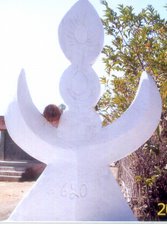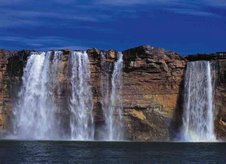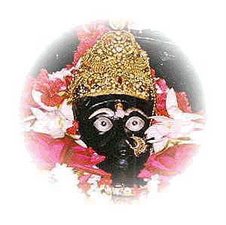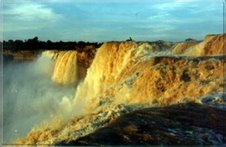
Special Economic Zones or SEZs as they are called in India are part and parcel of the New Economic Policy elaborated by the World Bank and imitated by their Indian agents. Since the early nineties the mainstream political parties of India are following the dictates of the imperialist powers and their anti-people puppet institutions e.g. the World Bank (WB) and the International Monitory Fund (IMF).
As if these two were not sufficient to destroy the poverty-ridden third world, in 1995 another organisation: the World Trade Organisation (WTO) was added to destroy completely the local industry and agriculture of the third world. Look, how the people in Asia, Africa and Latin America are suffering in their millions in the hands of international corporate fascism! The aim of the New Economic policy is to dismantle the public sector institutions built-up brick by brick during the last 6 decades with a lot of public wealth so that a colony of British Empire could face the challenges of poverty and destruction due to the ‘partition’ willfully imposed by the British rulers. It is wrong to say that the western educated Indian rulers wanted to build up the post-partition Indian economy where the role of private capital would be minimum or zero.
Rather, on the specific requests of Indian trading private capital, public sector organisations were created to serve the long term interests of these private traders of yesteryear and till today that is the philosophy of Indian public sector (PSU). Indian private capital till today is not interested in long term investment in infrastructure and capital goods industry. Their only target was to trade or work as commission agents.
Many of present day stalwarts of industry and commerce in India started work as ‘managing agents’ and earned huge amounts of surpluses by corrupt, fraudulent and illegal means. In all businesses where these stalwarts entered, the only philosophy of business was to earn quick profits at the cost of the national interest. In foreign trade, invoices were made fake fictitiously, foreign exchange earned were kept abroad, in preparation for the annual accounts required for Company Law and Income Tax Law, everything was manipulated, and corruption everywhere was the order of the day.
MNCs like Hindustan Lever, Imperial Tobacco, Siemens, and Philips etc. were also making quick bucks and putting pressure on the political system to allow more and more MNCs to come to India so that imperialists would enjoy the same freedom to exploit India’s one billion population as the East India Company enjoyed from 1757 to 1858 and the British Raj till 1947.After the death of Mao Zedong the Chinese Communist Party adopted the age old ‘capitalist’ path resulting in huge investments of MNCs from the rest of the world.
Today Chinese goods are on the shelves of almost all the retail trading houses of the world. The phenomenal growth of China both in economic expansion and in military might frighten the imperialists. The North Atlantic Treaty Organisation headed by the US wants to create a buffer between China and them. On their advice, the Indian ruling class decided to follow the same Chinese route of economic activity, of course, without nuclear war power.
The slogan was, ‘liberalisation, privatisation and globalisation’ (LPG). The Indian ruling class on the advice of their foreign masters handed over the future of more than a billion population to organised international criminal corporate houses without developing any type of checks and balances as is normal in the developed world.
China has one party rule and they are very strict in enforcing the rules on their business houses. In US laws are meant to help unrestricted working of the corporate sector, but they can’t go beyond the four walls of law. Enron, for example in recent history, was doing a roaring business throughout the globe but once detected of ‘window dressing’ or fraud, the entire structure was crushed.
Both Mr. Ratan Tata and Mr. Lakshmi Mittal faced all sorts of hurdles before they could acquire those steel companies in the EU. No one can imagine that can happen in India, though Indian stalwarts like Pandit Nehru promised to hang them on a ‘lamp post’ if they indulged in corruption, adulteration and cheating the nation. Thus the in Indian context everything is allowed provided one knows whom to approach! On the international ‘corruption index’ India is in a ‘respectable’ high position, but on the ‘human development index’ India’s placement is in the 125th or 127th among the 180 odd countries.
This is in short the real lesson from the long story of ‘9 to 10 percent growth or development’ of this subcontinent during the last six decades.IIIn our school textbooks during colonial days we read that ‘Indian agriculture depends on the monsoon’, and today after 60 long years of so-called ‘independence’ day in day out all the media show the progress of monsoon since the first week of June every year. Why is the monsoon is so important to-day? What happened to the crores of rupees spent on big dams and irrigation projects? Where are those contractors, politicians and engineers who cheated this country? Around 700 million people are still in the villages of India whose only occupation is agriculture.
Most of the holdings are either small or marginal. Big size holders of land are very small in number. The increasing cost of cultivation, uncertain market conditions and high rate of interest for private loans are causing widespread bankruptcy among increasing number of cultivating families. ‘Farmers’ deaths’ are no longer news; one may get international awards by highlighting the total failure of Indian agriculture.
It is happening every day in different parts of the country. Even ‘once upon a time very rich Punjabi farmers’ are committing suicide because they can’t pay their debts. Farmers in Vidarbha in Maharashtra are selling their human organs to pay off debt, in Punjab one finds advertisements that this or that village is ‘on sale’. Even then the Indian representatives in World Economic Forum meetings is increasing year after year!
From the face of these representatives of Indian destitutes there is hardly any expression that they at all think of this country and its billion populations.Who is responsible for this sorry state of affairs? We were told that ‘green revolution’ and ‘white revolution’ were achieved in India. But in recent times our internal production of cereals, lentils, cooking oils and so on are short in supply and India is forced to import them at any price, because the internal price of these commodities of these day to day requirements are sky high.
In the same manner milk and milk products are imported by MNCs and distributed in the country. We read everyday discussions on ‘food security’, minimum calories etc.etc. but who is going to implement it in a World Bank dictated ‘market economy’. Food, clothing and shelter are meant for those who have purchasing power, but how many Indians earn one US $ a day for 365 days in a year. One US $ gets now Rs 40 ( in future it will fall further) and the official urban minimum wage is double or treble of this figure in many urban centres in India. One kilogramme of flour costs around Rs. 20 and it is impossible for a family of 5 or 6 members to live on Rs 40 per day income.
The villages of India are destroyed by the well planned economic policies followed by the mainstream political parties: both the UPA supported by the ‘left’and the NDA. The recent birth of the UNPA, as a form of another cartel in the political bazaar of India deserves observation, as AIDMK and others betrayed in recent Presidential election!The present economic situation in rural India is the result of a well thought-out strategy of the imperialist powers.
Both the US and the EU have to maintain their agricultural sector with a huge subsidy and they want a greater market share in the developing countries. That is why the WTO forced India to withdraw all import duties on agricultural commodities but refused to withdraw their own subsidies and flatly denied to reduce import restrictions on agricultural commodities from the third world countries. Result is, as an example, Indian cotton growers can not compete with imported subsidised cotton from US and when they run in huge debt they are forced to commit suicide. ‘Genetically modified (GM)’ crops grow in huge quantity and developed countries want market in the developing countries. These GM crops are dangerous for man and beast.
We don’t know whether India is importing any GM crop and in what quantity. But they are selling GM seeds manipulating politicians. Even the judiciary is party to this anti-people conspiracy of the MNCs. Our policy makers willingly never allowed either private or public investments in agriculture, though around two-third of our workers are directly dependent on agriculture. This is the largest private sector in India, a family of 5 or 6 are directly engaged in his or her tiny farm during the crop season New economic reform measures of Government of India want to utilise the golden opportunity of man made agricultural bankruptcy to throw out millions of this country from this occupation! What is the alternative for these hapless people?IIIRelatively backward states like Chattisgarh, Jharkhand and Orissa are rich in minerals and water resources. Tribals are the significant population in these states. Where tribals live below the surface of their huts and cultivating land there is huge reserve of iron ore, manganese, coal, bauxite etc. etc. – costly mineral resources of the country in huge quantity. Both Indian Corporates and MNCs are flocking in large numbers to these three states and negotiating with the local corrupt politicians of the state governments to get ownership rights of these mineral resources.
Every one wants to acquire ‘captive mines’, so that they can make this country empty of minerals within no time. They want to start factories to process these minerals into finished products and /or export raw minerals to foreign countries. Paradeep port on Orissa coast was developed by Japan long ago to export iron ore.
Now China is the largest buyer of iron ore from India though they have their own huge reserve of ore. They have stopped export of their own iron ore. There is no ‘national’ mineral policy of the Government of India in general and on iron ore in particular. It is decided ad hoc, based on who will earn what amount. Exhaustible minerals like coal, iron ore and others are not exported when the country like India needs it for its mere survival. The centre is committed to export, it has nothing to do with ‘national interest’.
In the recent Corus takeover negotiations of the Tatas, the Government of India is reported to have assured the Tatas of cheaper iron ore from India. The same assurances were probably given to NRI businessman Mr. Mittal. Everyone wants exclusive ownership of captive mines from where they can withdraw as much as they want at the minimum price to be decided by the politicians irrespective of price escalation in the world market.
This is practiced only in India, nowhere else in the world. This is only one example how corporate loot is openly allowed by the new economic policy dictated by the WB, IMF and WTO.IVThe same thing has happened with POSCO (Pohang Steel Company Ltd.) of South Korea. This is a big steel producer in the world and it has steel plants in many countries.
On June 22, 2005 POSCO and Government of Orissa entered into an agreement that this foreign company will invest around $12 billion (now around Rs 48000 crores and it may go down further in future with appreciation of Rupee) and produce around 12 million tones of steel per annum.
They will use around 600 million tons of iron ore and export around 400 million tons of good quality ore through a captive port to be developed near the existing Paradeep port. The project will get water from the Mahanadi barrage at Jobra and Naraj in Cuttack. As there is no surplus water available, who will suffer when Posco starts withdrawing water. Why do not they use the sea water after processing? Centre has given the green signal to the Project as an SEZ and therefore, it is entitled to all the concessions of an SEZ. The project requires a land area of 4004 acres in three panchayats: Gadakujang, Dhinkia and Nuagaon in the district of Jagatsinghpur. They will require more land for developing infrastructure. The government claims that 471 families will be affected and many of them have already accepted compensation! However, in their meetings those who protest against acquisition claim attendance of more than 20,000 people of around 4000 families. Why is the Orissa government not telling the truth? Whom they are afraid of?Why is FDI in steel making required in 2007? Don’t we have enough Indian producers of steel; both in the Private and Public sector. Is it that our steel makers don’t have enough funds for investment? Some of them are migrating to distant lands to produce steel. During the last one year two big steel companies were sold out outside India because the owners failed to run it profitably. One was purchased by Mr Mittal, an NRI and the other was acquired by Mr Tata. One of the main reasons why they were sold is because cost of iron ore is getting costlier day by day. China produces huge quantities of steel, it has its own iron ore reserves, but imports from rest of the world, including India, a huge quantity of iron ore every year. It refuses to export its own ore.
Indian rulers have decided recently to allow export of more and more good quality ore to foreign countries, depriving the future generations of this precious mineral. Will the people of India accept such an anti national policy of the Centre? This is another form of state terrorism.VRegarding Posco project, there is no scope of transferring 4000 acres of fertile agricultural land for a steel factory.
People of these three panchayats have refused to allow either government representatives or the salaried staff of the Korean company to enter into their villages, as was done in Nandigram in West Bengal or Kalinganagar in Orissa. The local economy is a thriving, labour-intensive one based on agriculture and fishing. Apart from paddy, coconut etc., cash crops like betel (pan), cashew, supari and kewra are produced in huge quantities and sold throughout the country. Its betel leaves fetch huge profit during the Diwali festival from north and west India. Many families of this area can give employment to the staff of Posco against their vague promise of ‘one member of each affected family’ and that too temporary unskilled job with no minimum wage law as it is a SEZ project (no law of the land is enforceable in the SEZ area). How stupid is this?
The government claims that out of 4000 acres of land given to Posco, 3566 acres is forest land and belongs to the government. We hope Naveen Patnaik, chief minister, and his team of NDA government in Orissa knows that forest land belongs to those who live in forest and no government can throw them out as they used to do in the past before the Forest Law was passed last year.
Even the Ministry of Forest and Environment cannot help Naveen babu though it is well known throughout the country as anti people, anti forest and anti environment. It is worth reminding our friends in Orissa and in Delhi, the forest that we find along the coast line of Orissa is a must in this area as the area is prone to frequent cyclone and storm. Have we forgotten the Tsunami and Indian coastal people!
Are they not still suffering! Will Koreans allow their company to endanger the life of lakhs of coastal people of Orissa to earn some pennies as profit?The group of ministers appointed by the Prime Minister’s Office to go into SEZ policy after the Nandigram massacre in March 2007 recommended that SEZs should not be set up in areas of cultivable land, then how Posco was recognised for SEZ by Mr. Kamal Nath ?. Why are not state governments instructed by the PMO to do a land survey before they enter into a Memorandum of Understanding?
This happened with Tata as he was to be given some ‘gift of land at Singur’ in West Bengal by CPI (M). Singur has the best cultivable land in West Bengal producing more than one crop each year. Paradeep port has sufficient capacity so why is an additional port being built by its side by Posco which will endanger the fishing industry and the life of thousands of rare turtles ? Is the central ministry of shipping, road transport and highways sleeping on the entire issue?
Regarding the resettlement of the affected families in the Project area, where is the promised law of settlement of SEZ-affected people and in the absence of that how is the Orissa government allowed to approach individual landholders. Why is not Posco advised to approach individual land owners, instead of using the colonial 1894 Act. Mr Chief Minister of Orissa should sit down with his counter part in Karnataka, because both of them are running NDA governments and ask the latter about land acquisition for industrialisation.
The Karnataka government wants industrialists to directly approach landowners and the government has no role in the matter.This project will establish captive iron ore mines, why? Let them purchase iron ore from the Indian market or elsewhere and carry on their steel production. In China this company is not given any captive mines. Let them pay the increasing price of iron ore prevalent in the international market during the next 30 years. In the same manner both Tatas and Mittals are assured by their benefactors to allocate ‘captive mines’ in Orissa and Jharkhand. How long such anti- people, anti- national policies will be pursued by the governments?
Kamal Nath, Union Minister of Commerce, friend and philosopher of the SEZ in India is reported in the press that he is angry with the Reserve Bank of India and Ministry of Finance for denying various concessions that he wants to give to the industrialists within the SEZs. In a market economy, which his Prime Minister advocates, competition is the catchword and the government has no role to play as was the case before the Economic Reform started in 1991. Why should the people in the SEZs not pay the market rate of interest as was decided by the RBI? Why does he want real estate companies to be exempted in SEZ areas? Why should not they pay all the taxes as millions of ordinary citizens pay as per the Finance Act? Initially we were told that China’s growth is due to excellent export performance. They have 5 Special Economic Zones for exclusive export. Now the Indian Commerce Ministry clarifies that units established within SEZ may not export, but they will enjoy all the concessions and privileges. Do we have any rule of law in this country? If the UPA Govt. supported by ‘left’ feels that both Indian and foreign corporate houses are to be enriched at the cost of national interests, let us debate it first in the country then implement it. Both the UPA and the ‘left’ combine and the NDA are bankrupt political combines, their main interest is to give all bureaucratic protection to the corporates to mercilessly loot the country’s natural resources and thereby keep the vast majority of the population deprived permanently of food, clothing and shelter.
These poor homeless people demanded land for shelter from the Andhra Pradesh government but got bullets in return. The same story happened in Nandigram, a state ruled by the ‘left’. Will Kamal Nath and Co. restrain themselves from the ruthless destruction of millions of cultivating families, otherwise they will be left with no other alternative than to resist all attempts of the government to make them paupers and destitutes. Indians are adamant in achieving their demand to survive in their land of origin. No forces of earth can deprive their inherent ‘right to life and livelihood’.source:revolutionary democracy
source- koyatoor










2 comments:
The example of Comrade Hugo Chavez should be followed, as he broke out of the IMF and World Bank, and payed the debt of Argentina.
Please note the reference to Imperial Tobacco does NOT relate to Imperial Tobacco Group PLC, which has no business interests in India.
Post a Comment